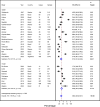Prevalence and incidence of diabetic retinopathy in patients with diabetes of Latin America and the Caribbean: A systematic review and meta-analysis
- PMID: 38574018
- PMCID: PMC10994322
- DOI: 10.1371/journal.pone.0296998
Prevalence and incidence of diabetic retinopathy in patients with diabetes of Latin America and the Caribbean: A systematic review and meta-analysis
Abstract
Objectives: This systematic review aimed to assess the prevalence and incidence of diabetic retinopathy in patients with diabetes of Latin America and the Caribbean.
Methods: We searched Web of Science (WoS)/Core Collection, WoS/MEDLINE, WoS/Scielo, Scopus, PubMed/Medline and Embase databases until January 16, 2023. We meta-analyzed prevalences according to type 1 diabetes mellitus (T1DM) and type 2 diabetes mellitus (T2DM).
Results: Forty-three prevalence studies (47 585 participants) and one incidence study (436 participants) were included. The overall prevalence of retinopathy in patients with T1DM was 40.6% (95% CI: 34.7 to 46.6; I2: 92.1%) and in T2DM was 37.3% (95% CI: 31.0 to 43.8; I2: 97.7), but the evidence is very uncertain (very low certainty of evidence). In meta-regression, we found that age (T1DM) and time in diabetes (T2DM) were factors associated with the prevalence. On the other hand, one study found a cumulative incidence of diabetic retinopathy of 39.6% at 9 years of follow-up.
Conclusions: Two out of five patients with T1DM or T2DM may present diabetic retinopathy in Latin America and the Caribbean, but the evidence is very uncertain. This is a major public health problem, and policies and strategies for early detection and opportunely treatment should be proposed.
Copyright: © 2024 Medina-Ramirez et al. This is an open access article distributed under the terms of the Creative Commons Attribution License, which permits unrestricted use, distribution, and reproduction in any medium, provided the original author and source are credited.
Conflict of interest statement
The authors have declared that no competing interests exist.
Figures
Similar articles
-
Prevalence and incidence of chronic obstructive pulmonary disease in Latin America and the Caribbean: a systematic review and meta-analysis.BMC Pulm Med. 2022 Jul 16;22(1):273. doi: 10.1186/s12890-022-02067-y. BMC Pulm Med. 2022. PMID: 35842603 Free PMC article.
-
Incidence and Risk Factors for Developing Diabetic Retinopathy among Youths with Type 1 or Type 2 Diabetes throughout the United States.Ophthalmology. 2017 Apr;124(4):424-430. doi: 10.1016/j.ophtha.2016.10.031. Epub 2016 Nov 30. Ophthalmology. 2017. PMID: 27914837 Free PMC article.
-
Prevalence of hypertension in adults living at altitude in Latin America and the Caribbean: A systematic review and meta-analysis.PLoS One. 2023 Oct 12;18(10):e0292111. doi: 10.1371/journal.pone.0292111. eCollection 2023. PLoS One. 2023. PMID: 37824544 Free PMC article.
-
Prevalence and risk factors for diabetic retinopathy in Asian Indians with young onset type 1 and type 2 diabetes.J Diabetes Complications. 2014 May-Jun;28(3):291-7. doi: 10.1016/j.jdiacomp.2013.12.008. Epub 2014 Jan 6. J Diabetes Complications. 2014. PMID: 24512748
-
Prevalence, incidence and future projection of diabetic eye disease in Europe: a systematic review and meta-analysis.Eur J Epidemiol. 2020 Jan;35(1):11-23. doi: 10.1007/s10654-019-00560-z. Epub 2019 Sep 12. Eur J Epidemiol. 2020. PMID: 31515657
Cited by
-
One-year results of visual response following intravitreal novel anti-VEGF injection for diabetic macular edema in a Latino population.Int J Retina Vitreous. 2025 Aug 1;11(1):89. doi: 10.1186/s40942-025-00719-9. Int J Retina Vitreous. 2025. PMID: 40750915 Free PMC article.
-
Retrospective Study of Diabetic Retinopathy and Macular Edema in Southern Part of Bangladesh.J Ophthalmol. 2024 Jun 6;2024:8437947. doi: 10.1155/2024/8437947. eCollection 2024. J Ophthalmol. 2024. PMID: 38873280 Free PMC article.
References
-
- Steinmetz JD, Bourne RRA, Briant PS, Flaxman SR, Taylor HRB, Jonas JB, et al.. Causes of blindness and vision impairment in 2020 and trends over 30 years, and prevalence of avoidable blindness in relation to VISION 2020: the Right to Sight: an analysis for the Global Burden of Disease Study. The Lancet Global Health. 2021;9: e144–e160. doi: 10.1016/S2214-109X(20)30489-7 - DOI - PMC - PubMed
-
- Grintsova O, Maier W, Mielck A. Inequalities in health care among patients with type 2 diabetes by individual socio-economic status (SES) and regional deprivation: a systematic literature review. International Journal for Equity in Health. 2014;13: 43. doi: 10.1186/1475-9276-13-43 - DOI - PMC - PubMed
Publication types
MeSH terms
LinkOut - more resources
Full Text Sources
Medical




